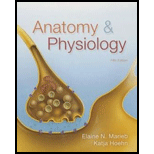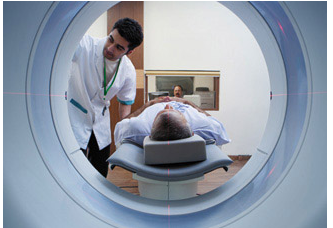
Mr. Heyden, a somewhat stocky 72-year-old man, is brought in to the emergency room (ER). The paramedics report that his left arm and the left side of his body trunk were pinned beneath some wreckage in a bus accident, and that when he was freed, his left hypogastric and lumbar areas appeared to be compressed and his left arm was blanched and without sensation. On admission, Mr. Heyden is alert, slightly cyanotic, and complaining of pain in his left side; he loses consciousness shortly thereafter. His vital signs are taken, blood is drawn for laboratory tests, and Mr. Heyden is catheterized and immediately scheduled for a CT scan of his left abdominal region.

Analyze the information that was subsequently recorded on Mr. Heyden’s chart:
Urinalysis: Some granular casts (particulate cell debris) are noted, and the urine is brownish-red in color; other values are normal, but urine output is very low. An order is given to force fluids.
(a) What might account for the low volume of urine output? (Name at least two possibilities.) (b) What might explain the casts and abnormal color of his urine? Can you see any possible relationship between his crush injury and these findings?
The next day, Mr. Heyden is awake and alert. He says that he now has feeling in his arm, but he still complains of pain. However, the pain site appears to have moved from the left upper quadrant to his lumbar region. His urine output is still low. He is scheduled once again for a CT scan, this time of his lumbar region. The order to force fluids is renewed and some additional and more specific blood tests are ordered. We will visit Mr. Heyden again shortly, but in the meantime think Think about what these new findings may indicate.
Want to see the full answer?
Check out a sample textbook solution
Chapter 25 Solutions
Anatomy and Physiology - With CD and Atlas and Lab. Man.
- Explain the meaning of third-spacing.arrow_forwardCompensation for metabolic alkalosis involves increase in pulmonary ventilation; increase in loss of bicarbonate in urine increase in pulmonary ventilation; decrease in loss of bicarbonate in urine decrease in pulmonary ventilation; decrease in loss of bicarbonate in urine decrease in pulmonary ventilation; increase in loss of bicarbonate in urinearrow_forwardIn an elderly person with respiratory acidosis due tochronic respiratory congestion, why would decreasedkidney function be so dangerous?arrow_forward
- Explain the mechanism of bicarbonate reabsorptionarrow_forwardTwo of the key carbonic anhydrases are in the muscles and in the lungs. What would you expect the major difference would be between these carbonic anhydrases?arrow_forwardWhat is the arterial PCO2 in metabolic acidosis or alkalosis?arrow_forward
- How would carbon dioxide loading/oxygen unloading at systemic tissues be affected if a person was exposed to a chemical that blocked the action of the enzyme carbonic anhydrase? Explain why.arrow_forwardAn elderly, semiconscious patient is tentatively diagnosed ashaving acidosis. What components of the arterial blood will bemost valuable in determining if the acidosis is of respiratoryorigin?arrow_forwardIf bicarbonate ion is lost from the body, how will carbonic acidlevels change?arrow_forward
 Human Physiology: From Cells to Systems (MindTap ...BiologyISBN:9781285866932Author:Lauralee SherwoodPublisher:Cengage Learning
Human Physiology: From Cells to Systems (MindTap ...BiologyISBN:9781285866932Author:Lauralee SherwoodPublisher:Cengage Learning Human Biology (MindTap Course List)BiologyISBN:9781305112100Author:Cecie Starr, Beverly McMillanPublisher:Cengage Learning
Human Biology (MindTap Course List)BiologyISBN:9781305112100Author:Cecie Starr, Beverly McMillanPublisher:Cengage Learning Anatomy & PhysiologyBiologyISBN:9781938168130Author:Kelly A. Young, James A. Wise, Peter DeSaix, Dean H. Kruse, Brandon Poe, Eddie Johnson, Jody E. Johnson, Oksana Korol, J. Gordon Betts, Mark WomblePublisher:OpenStax College
Anatomy & PhysiologyBiologyISBN:9781938168130Author:Kelly A. Young, James A. Wise, Peter DeSaix, Dean H. Kruse, Brandon Poe, Eddie Johnson, Jody E. Johnson, Oksana Korol, J. Gordon Betts, Mark WomblePublisher:OpenStax College


